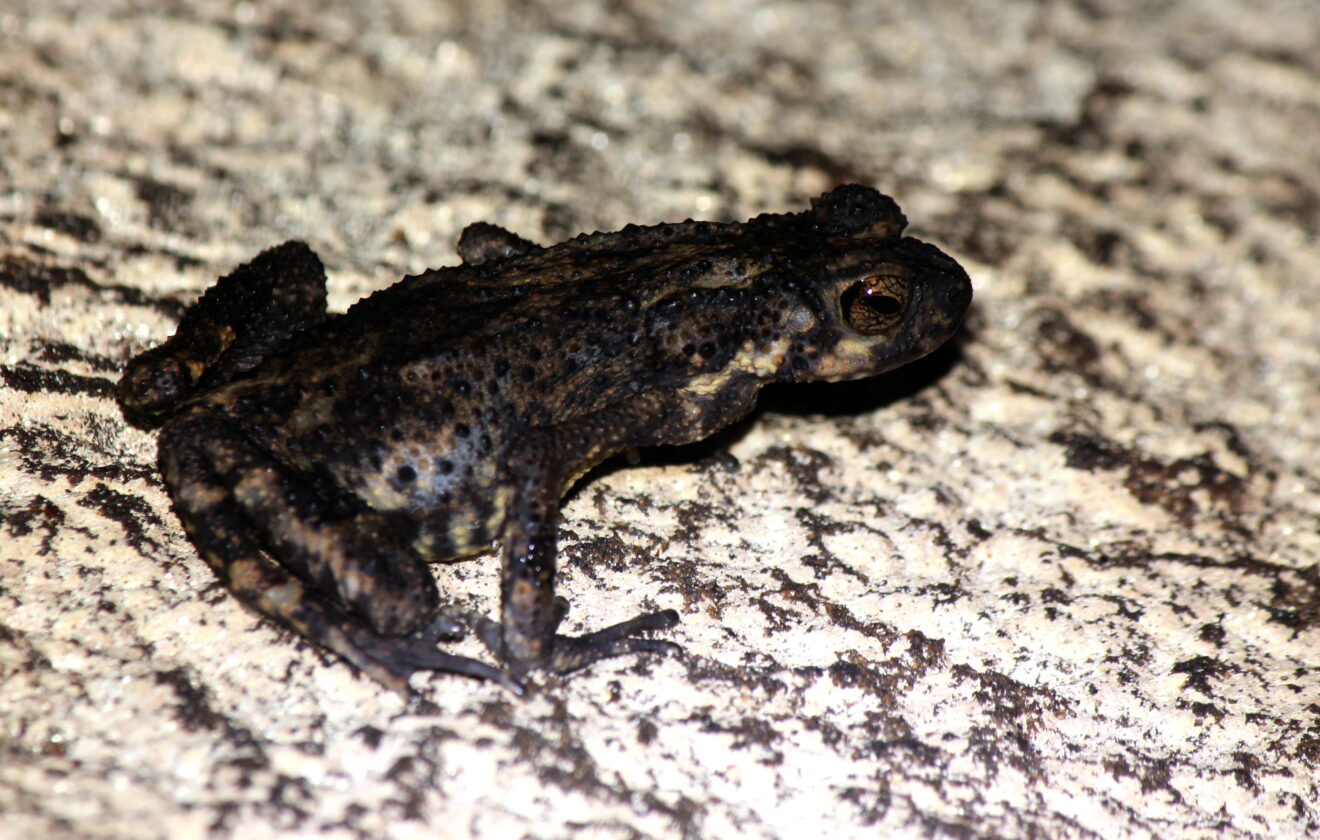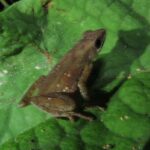- Adenomus kelaartii: Exploring the Secretive Life of Kelaart's Dwarf Toad
- Taxonomy and Classification
- Natural Habitat: Secrets of the Montane Cloud Forests
- Physical Characteristics: Evolution in Miniature Form
- Behavior and Life Cycle: Fascinating Strategies for Survival
- The Ecological Role: Essential Yet Subtle Influencers
- Threats and Conservation Status
- Cultural and Scientific Significance: Symbolism in Conservation Efforts
- Conclusion: Advocating for an Ambitious Conservation Vision
Adenomus kelaartii: Exploring the Secretive Life of Kelaart’s Dwarf Toad#
The verdant rainforests and mist-shrouded montane forests of Sri Lanka harbor a fascinating, often overlooked amphibian treasure—the diminutive yet captivating Kelaart’s dwarf toad (Adenomus kelaartii). Hidden among moss-draped logs and crystalline mountain streams, this elusive creature tells an eloquent tale of adaptation, ecological balance, and conservation urgency. Despite its modest size, this frog carries within its delicate form a story of biological resilience and vulnerability, captivating scientists and naturalists alike.
Named after Edward Frederick Kelaart, a pioneering British naturalist who first documented its existence in the mid-19th century, Adenomus kelaartii demonstrates how much remains to be learned about the species thriving quietly in the shadows of biodiversity hotspots. Did you know, for instance, that while many frogs prefer wet lowland ecosystems, Kelaart’s dwarf toad thrives in the cooler, high-altitude rainforests and cloud forests of central Sri Lanka—regions significantly affected by changing weather patterns and habitat fragmentation?
Join us in this immersive exploration into the natural history, ecology, and conservation of Adenomus kelaartii, shedding light on an amphibian whose quiet presence is deeply woven into the fabric of Sri Lanka’s ecological tapestry.
Taxonomy and Classification#
Kelaart’s dwarf toad belongs to the order Anura, within the family Bufonidae—the “true toads,” widely recognized by their notably drier, warty skins and robust yet compact appearance. Within this family exists a lesser-known genus—Adenomus—which comprises a small number of highly specialized species unique to Sri Lanka. The specific name “kelaartii” honors Edward Frederick Kelaart, whose pioneering scientific pursuits greatly enriched our understanding of Sri Lanka’s flora and fauna during the colonial period.
Close Relatives and Genetic Insights#
Taxonomically speaking, the genus Adenomus is closely related to other Sri Lankan endemic genera such as Duttaphrynus and Nannophrys. Genetic analyses have unveiled interesting evolutionary relationships among these amphibians, indicating distinct divergence occurring due to geographical isolation and niche specialization over millions of years. Scientifically significant for evolutionary biologists, studying the genetics of Adenomus kelaartii provides insights into the broader evolutionary history and ecological adaptations governing island-endemic amphibians.
Natural Habitat: Secrets of the Montane Cloud Forests#
Endemic exclusively to Sri Lanka, Adenomus kelaartii resides in high-altitude ecosystems primarily ranging between 1,200 and 2,400 meters above sea level. The cooler, often mist-shrouded montane regions hosting these creatures include well-known biodiversity hotspots such as Horton Plains National Park, Peak Wilderness Sanctuary, and Hakgala Strict Nature Reserve.
These forests possess a magical, ethereal vibe, characterized by gnarled evergreen trees draped in moss, patches of lush ferns, and a consistently humid climate fed by morning mists and afternoon rains. Amid this lush landscape, Kelaart’s dwarf toad finds refuge, blending seamlessly with forest debris, leaf litter, and moist soil.
This unique setting suits their precise ecological needs. Sheltered from predators beneath logs or stones during daylight hours, they emerge cautiously after rains—humid conditions providing essential moisture that allows their permeable skins to remain hydrated. Crystal-clear streams and temporary water pools, abundant in these ecosystems, provide the perfect breeding sites for their eggs and larvae.
Physical Characteristics: Evolution in Miniature Form#
One of the distinctive aspects of Adenomus kelaartii is its compact, modest size. Adults typically measure between only 25 to 35 millimeters in length. At first glance, this toad’s subtle earth-toned palette of browns, greys, and greens—often accented with small, cream-colored speckles—may appear humble. However, a closer look reveals beautifully intricate patterns that serve as camouflage, mirroring the textures of leaf litter and fallen bark.
Its skin, though characteristically warty as typical of the Bufonidae family, holds finely textured granular glands that are vital adaptations. These glands secrete defensive toxins capable of deterring potential predators—mostly small birds and mammals common to montane forests. Remarkably expressive eyes, slightly protruding from a round head, grant these creatures a near panoramic view, an advantage when scouting their surroundings from beneath cover.
More interestingly, powerful hind limbs, although relatively short, facilitate agile leaps and rapid movements—essential skills when escaping predators or darting into streams. Equipped with webbed feet adapted for swimming, their strong yet delicate digits assist in navigating leaf-strewn forest floors and rocky streambeds efficiently.
Behavior and Life Cycle: Fascinating Strategies for Survival#
Life unfolds rhythmically for Kelaart’s dwarf toad, dictated largely by the heartbeat of the forest itself: rainfall. Like other amphibians, hydration is critical for survival, reproduction, and overall behavioral patterns. These nocturnal amphibians take advantage of nighttime moisture, emerging discreetly from their daytime shelters to forage. Typical prey includes a smorgasbord of small insects like ants, beetles, termites, and occasionally tiny arachnids, ensuring the essential nutrient intake for maintaining health and reproductive vitality.
Unique Mating Rituals and Parental Care#
With rainfall acting as nature’s subtle signal, males initiate reproduction through melodic, low-frequency calls that resonate softly beneath the canopy—each male presenting an auditory invitation competing for female attention. Upon selecting their partner, females lay modest clusters of eggs in shallow, ephemeral pools formed by rainfall. Intriguingly, both parents display unusual investment compared to many amphibian counterparts, remaining nearby during initial egg development to help deter predators and assist if pools dry prematurely, even relocating clusters to more suitable pools when required.
Tadpoles undergo rapid metamorphosis in these temporary pools—an adaptation enhancing offspring survival by reducing vulnerability to long-term aquatic predators. Within weeks, these tiny juvenile frogs disperse silently into surrounding mossy cover, beginning their hidden, cautious existences as fully terrestrial organisms.
The Ecological Role: Essential Yet Subtle Influencers#
Despite their discreet nature and small stature, Kelaart’s dwarf toads maintain indispensable roles within their ecosystems. Acting as both predators of insects and prey to higher predators, they create vital ecological balance. Significantly, amphibians like Adenomus kelaartii function as bioindicators; their health directly reflects environmental conditions. Stable, thriving populations point towards healthy ecosystems, whereas declines often indicate ecological distress due to habitat alteration or environmental pollution.
Threats and Conservation Status#
Currently classified as Vulnerable by the International Union for Conservation of Nature (IUCN), Kelaart’s dwarf toad faces several escalating threats. Chief among these is habitat loss driven by encroaching human settlements, agricultural expansion—particularly tea plantation encroachment—and deforestation. Climate change intensifies these threats by altering rainfall patterns, increasing extreme weather events, and raising temperatures, profoundly impacting amphibian life histories and reproductive success.
Amphibian chytridiomycosis—a devastating fungal disease responsible for widespread amphibian declines globally—poses yet another looming threat. Conservation initiatives, including strict habitat protection regulation enforcement, chytrid fungus monitoring, and public awareness campaigns continue to be critical measures aiding this sensitive species.
Cultural and Scientific Significance: Symbolism in Conservation Efforts#
Adenomus kelaartii exemplifies the beauty of focusing on delicate ecological details. While not widely embedded in folklore, their existence symbolizes Sri Lanka’s unique biodiversity, highlighting underlying conservation challenges. Scientifically important, these toads provide pivotal insights into evolutionary adaptation, genetic divergence, climate change sensitivity, and conservation biology efforts relevant globally amid increasing environmental concerns.
Conclusion: Advocating for an Ambitious Conservation Vision#
Unveiling the hidden narratives of creatures like Kelaart’s dwarf toad reminds us profoundly of the interconnectedness and fragility underpinning our world’s ecosystems. Protecting species such as Adenomus kelaartii demands heightened awareness, sustained ecological research, and firm commitment to habitat conservation—steps critical for safeguarding not merely individual species but entire ecosystems threatened by anthropogenic pressures.
Let Kelaart’s dwarf toad serve as a poignant ambassador for biodiversity conservation—a species whose quiet strength and resilience provide inspiration and urgency alike. Every action counts; support conservation organizations, practice responsible ecotourism, and keep advocating for a sustainable coexistence with nature’s remarkable, irreplaceable living treasures.












